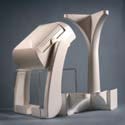Manufacturer Finds Better Results under Pressure
June 14, 2005
Originally Published MPMN June 2005
PROFILE
Manufacturer Finds Better Results under Pressure
Pressure-formed thermoplastic alloy improves performance and appearance of medical imaging instrument
|
The SKYLight system was redesigned using panels made from Kydex T, a thermoplastic alloy. |
Sometimes even the most innovative and advanced equipment can benefit from a slight redesign. In the case of one company, seeking out new manufacturing methods led to a more aesthetically pleasing product, as well as more cost-effective materials.
The SKYLight nuclear diagnostic imaging system from Philips Medical Systems (Milpitas, CA; www.medical.philips.com) is a gantry-free camera that features an open-floor design, allowing imaging of a patient in any position on any bed. The system also enables imaging of two patients simultaneously.
The original design used painted and textured fiberglass panels, which soon proved to be labor-intensive. “There were some variations from part to part with the fiberglass panels,” says Brent Shannon, mechanical engineer at Philips Medical Systems. “We found we had to deal with each part on an individual basis, which was time-consuming.” The company’s concerns with the inconsistencies, as well as a desire to reduce costs, led it to conclude that a new type of paneling was needed.
To find solutions to these challenges, Philips consulted pressure former Specialty Manufacturing Inc. (SMI; San Diego; www.smi-mfg.com) for design assistance, a material recommendation, and production of the thermoplastic enclosure system. SMI evaluated several thermoplastic sheet materials, recounts Haydn Forward, SMI’s vice president, including ABS, an ABS/ polycarbonate alloy, and an ABS/ PVC combination.
Kydex T, a proprietary alloy from Kleerdex Co. LLC (Bloomsburg, PA; www.kydex.com), was ultimately specified. “The material carries a UL Std. 94V-0/5V fire rating and, and based on our history with it, provides the formability, toughness, and color qualities required by the SKYLight application,” says Forward. “With impact resistance of 15 ft-lb/in., it also offers significantly better protection against impact from wheelchairs and gurneys than other thermoplastic materials we considered,” he adds.
|
Specialty Manufacturing Inc. pressure-formed the panels |
Formability and repeatability of the sheet were critical because the enclosure panels were redesigned with precise tongue-and-groove connections to simplify assembly. The snap-fit capability requires only 16 fasteners to secure all 36 parts comprising the enclosure. The tolerance of the tongue-and-groove connections is measured in thousandths of an inch, explains Forward. The tabs and receiving slots of the connections are formed into the panels during processing and maintain tolerances within 0.015 in.
The integrity of the tongue-and-groove connections also relies on the polymer’s memory of to maintain the shape of the part after the tabs and slots engage. “A key to this design is the natural memory of the thermoplastic sheet in achieving a snap-fit,” says Jack Schrieffer, engineering manager at SMI. “The stiffness and predictability of Kydex T sheet in this regard are crucial to the success of the novel design,” he adds.
Because the SKYLight instrument is produced in limited quantities, with part production typically in the hundreds per year, color consistency is also of special concern. “Philips must be able to mix and match components as necessary, whether for new units or as replacements, with no variation in color,” says Schrieffer. “Consistency of the Kydex T sheet enables us to offer the repeatability associated with a precision color house.” Forward explains that appearance also hinges on the ability of the thermoplastic sheet to accurately reproduce the acid-etched texture of the aluminum pressure-forming molds, and that the sheet reproduces mold finish with no part-to-part variation, even among deep-drawn parts.
The parts that SMI pressure-forms range in size to 30 sq in., with draws up to 9 in. Sheet thicknesses range from 0.187 to 0.250 in., depending on part size, shape, and rigidity.
Schrieffer explains that pressure- forming is an effective way to produce tight-tolerance parts in low volumes. “The sheer size of these parts would make injection molding a difficult and cost-prohibitive option,” he adds, “especially considering the large number of different parts and relatively low annual volume. We are able to achieve the appearance and fit of an injection-molded part with shorter lead times and lower tooling costs by using pressure-forming.”
Schrieffer also adds that pressure- forming enables the use of undercuts, which are critical to the tongue-and-groove design. Since there are no restrictions on the core-and-cavity interface with a female-cavity-only pressure-forming tool, it is easier to incorporate undercuts than it is in injection molding tools, which use costly collapsible cores to achieve the same result. With single-sided-aluminum pressure-forming tools, design changes can also be made faster and at significantly lower cost.
Multiaxis CNC equipment is used to trim pressure-formed parts. “A design change can often be accomplished by a simple CNC programming change, such as adjusting a height cut or an opening dimension. This makes pressure-forming even more attractive from cost and time-to- market viewpoints,” says Schrieffer.
SMI precisely controls heating of the sheet as an important element of the overall process parameters. “We know we can count on the consistency of each sheet of Kydex to react the same to our heating profile to yield repeatable results. The material is not only predictable, it provides an excellent balance of physical properties and formability required for this application,” says Schrieffer.
SMI received the Multi-Part Assembly Award in 2004 for the Philips SKYLight pressure-formed enclosure from The Society of Plastics Engineers Thermoforming Division.
Copyright ©2005 Medical Product Manufacturing News
You May Also Like



.png?width=300&auto=webp&quality=80&disable=upscale)
